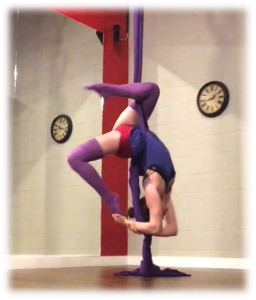Flexibility training is incredibly important for proper technique and injury prevention, but it is difficult to know how to effectively train without knowing more details. There are four main types of stretching I will cover in this post. Each has a slightly different technique and benefit. Whichever you choose to use, make sure you listen to your body. Stretching may not be the most comfortable, but it should NOT be painful. The American College of Sports Medicine (ACSM) recommends stretching to the point of tension or mild discomfort.
Types of stretching
• Static stretching: Static stretching involves holding a stretch in one position for a period of time (anywhere between 10-60 seconds).
• Dynamic stretching: Dynamic stretching involved a stretch performed repeatedly through a challenging range of motion. It can be great for warming up a joint or working on a functional range of motion.
• PNF stretching: Have fun stretching with a friend! PNF is an abbreviation for Proprioceptive Neuromuscular Facilitation. This type of stretching involves bringing the muscle into a lengthened position or slight stretch, and a period of contracting the stretched muscle (pushing against a partner), followed by a period of relaxing the muscle. When the muscle is relaxed, your partner pushes the muscle gently into a deeper stretch.
• Ballistic stretching: Ballistic stretching involves a bouncing motion in a stretched position. This can be dangerous for your muscles if they are not properly warmed. In general, Ballistic stretching can cause injury to tissues and will not give the same benefits as other forms of stretching.
When to stretch
I have to admit that because I love to stretch, I may be slightly biased. I would love to recommend stretching at any free moment throughout the day, but I know that my feelings towards stretching are not commonly shared. As a result, I have a few more realistic recommendations and tips to share! The ACSM guidelines recommend stretching at least 2-3 days per week for all major muscle groups, but it should be more frequent to increase flexibility. Stretches should be held for 10-30 seconds, accumulating 60 seconds per stretch. Stretching is the most effective when the muscles are warm, so be sure to get moving before you stretch!
Static stretching has longer lasting effects and is best used at the end of a workout. That being said, if you aren’t working out, it doesn’t mean you can’t stretch! One benefit of stretching is that it generally doesn’t require equipment, so it can be done anywhere. Static stretching can be done anytime throughout the day to improve flexibility and joint ranges of motion.
Dynamic stretching is great right before a workout as part of your warm up. Focus on the muscle groups that you plan to train, this will target the joints so they move smoothly, and get the muscles warm. It will not have the lasting effect of increasing overall flexibility, but it helps get your body ready for exercises with good technique to keep your body safe.
Joint Ranges of Motion
In my last blog, I introduced hypermobility of joints, or movement of a joint beyond its normal range. To provide a better idea of what a ‘normal’ range is, I have compiled a table of some major joints and their normal ranges of motion. Both the shoulder and hip are ball-and-socket joints, so they are able to move in more directions compared to a knee or elbow. Movement beyond these ranges suggest some joint hypermobility. Form and posture are important to keep in mind with hypermobile joints in order to keep them safe. Hypermobile joints in risky positions/movements can be subject to injury. In my third blog post, I will be looking at joint stability, and training to keep more mobile joints strong.
Adrienne Lema BPE Student
References:
1. ACSM Issues New Recommendations on Quantity and Quality of Exercise, American College of Sports Medicine (2015). Retrieved from http://www.acsm.org/about-acsm/media-room/news-releases/2011/08/01/acsm-issues-new-recommendations-on-quantity-and-quality-of-exercise
2. Blahnik, Jay. Types of Stretches, Full Body Stretching. (2011) 2nd Edition. Retrieved from http://www.humankinetics.com/products/all-products/Full-Body-Flexibility—2nd-Edition
3. Moroz, Alex. Physical Therapy, Range of Motion (2015). Merck Manual Prefessional Edition. Retrieved from https://www.merckmanuals.com/professional/special-subjects/rehabilitation/physical-therapy-pt
4. What Is Normal Range of Motion Of a Joint? About.com (2014). Retrieved from http://sportsmedicine.about.com/od/glossary/g/Normal-ROM.htm
Image References:
1. Lema, Adrienne (2015)
2. Family-fit.(2015) Retrieved from: http://wtespta.org/wp-content/uploads/2015/01/family-fit.jpg
3. Lema, Adrienne (2013)



